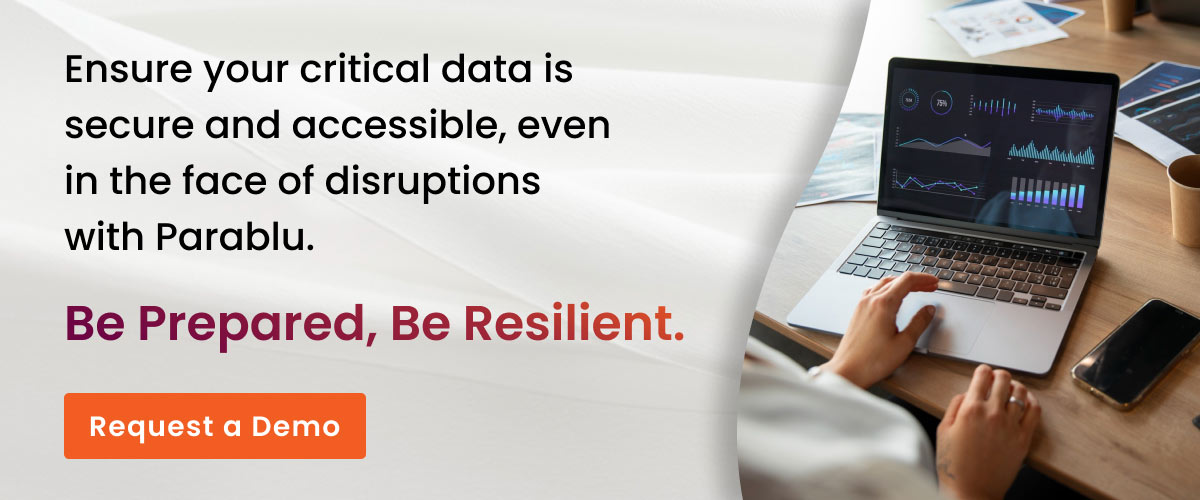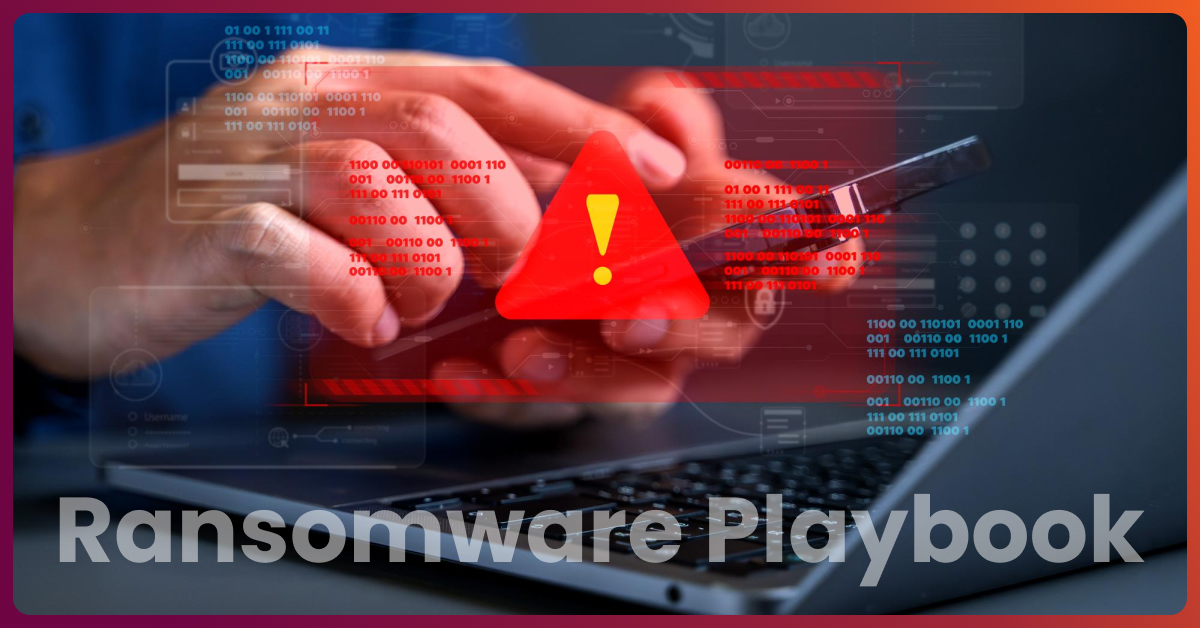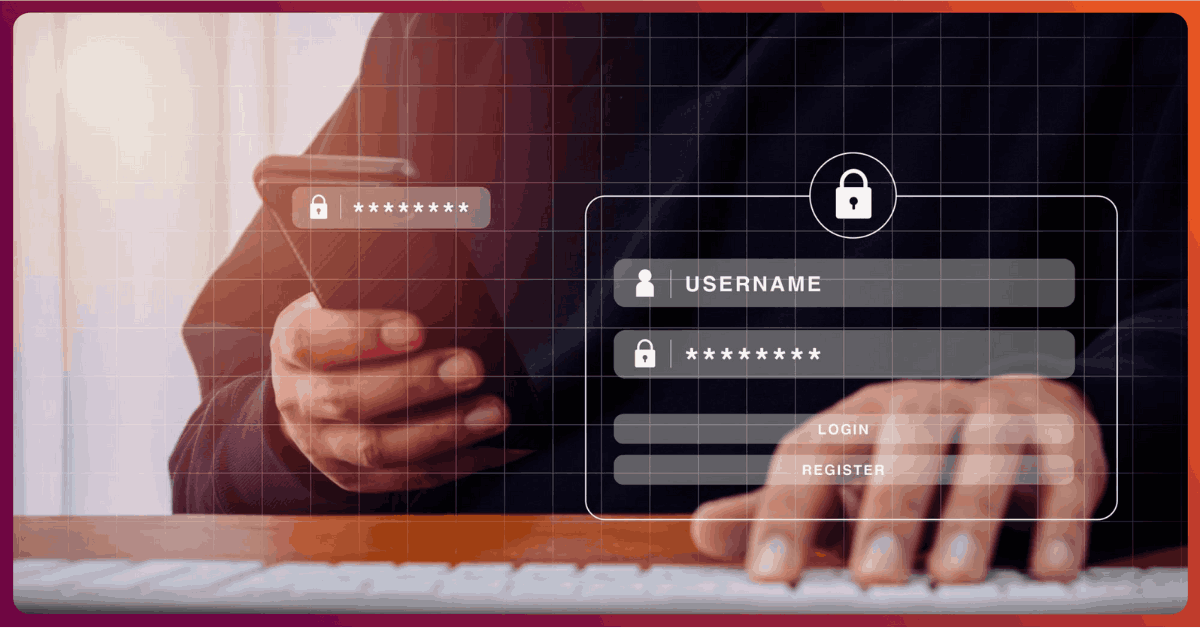The Essential Guide to Disaster Recovery (DR) and Business Continuity (BC)
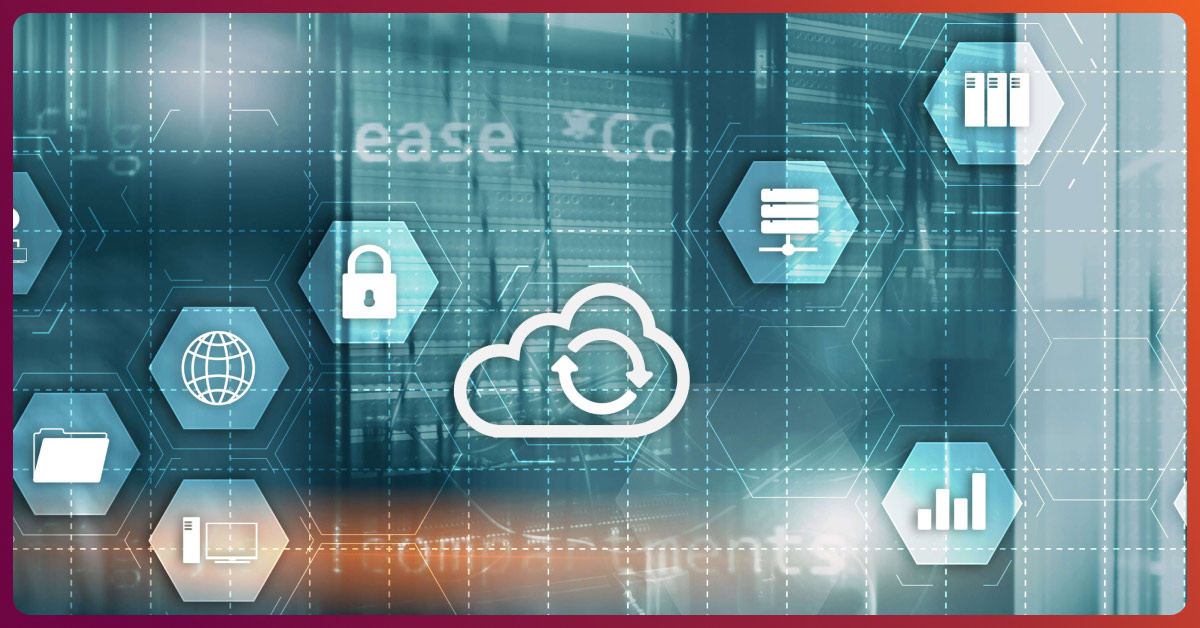
The threat landscape is rapidly changing, and the businesses can’t play a waiting game when it comes to planning their data protection strategy.
The stakes are getting bigger, and the attacks and security threats are a matter of when rather than if
Today, downtime can cost millions to organizations and cyberattacks can bring operations to a halt and make businesses go bankrupt.
Disaster recovery (DR) and business continuity (BC) have shifted from best practices to essential strategies.
For CISOs and CTOs responsible for protecting data, operations, and reputation, understanding the difference between DR and BC is crucial—though the lines can blur.
While both aim to manage risk, DR and BC play distinct roles. Each is vital for building a resilient business. This guide breaks down both, with statistics, real-world examples, and practical insights. Learn how to create a robust, integrated framework that keeps your organization prepared for any disruption.
A Quick Look at Key Stats
- 60% of organizations experienced at least one outage in the past three years.
- 93% of companies that suffer mass data loss become bankrupt within a year.
- 40% of businesses never reopen after a disaster. Also, another 25% close within a year.
- IT downtime costs businesses, on average, $5,600 per minute.
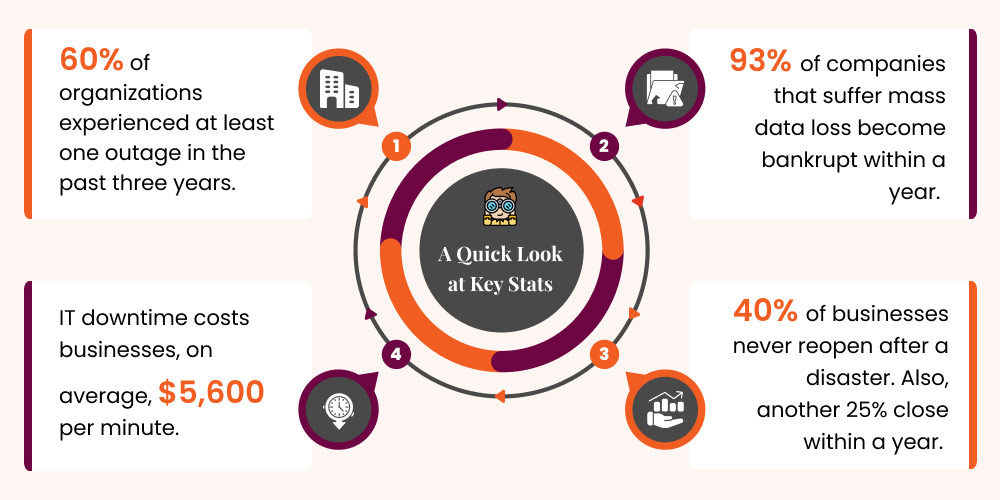
These statistics highlight why disaster recovery and business continuity should form any overall risk management strategy. But the businesses can still operate during and after disasters.
Defining Disaster recovery
Disaster recovery is the process through which business organizations can recover in case of uncertainty, such as a data breach, system failure, or natural calamity. It restores critical data and systems to enable the operation with minimal downtime, which could mean lesser financial loss.
That way, robust disaster recovery ensures that the data is safe, customer trust is sustained, and business operations are not affected. No matter how disastrous things get, in terms of cloud backups, failover systems, or offsite storage, disaster recovery does provide security. It is one of the most critical strategies that can be applied in business continuity for today’s unpredictable situation.
Key Elements of Disaster Recovery Plan:
- Data Backup and Restore: Regularly scheduled backups ensure that your data is retrievable in case of corruption or loss.
- Recovery Time Objective (RTO): The maximum time allowed to restore systems after a disruption.
- Recovery Point Objective (RPO): The maximum amount of acceptable data loss in the case of a disaster, measured in time.
- Failover Solutions: Systems like cloud-based disaster recovery, where operations automatically switch to secondary systems to avoid downtime.
- Testing and Updates: Regular simulations to test the effectiveness of the DR plan and to ensure backups and procedures are current.
Example of Disaster Recovery
Have you heard about “The Maersk Ransomware Attack?”
In 2017, the NotPetya ransomware attacked global shipping company Maersk and shut down 117 shipping terminals. The attack destroyed around 45,000 PCs, 4,000 servers, and over 2,500 applications. The entire business came to a halt, and employees used channels like WhatsApp to communicate.
Despite the scale of the damage, Maersk restored 100% of its operations in 10 days, thanks to a backup server in Ghana. This server, spared by a power outage, allowed them to rebuild their IT infrastructure. However, the attack cost the company between $250 million to $300 million.
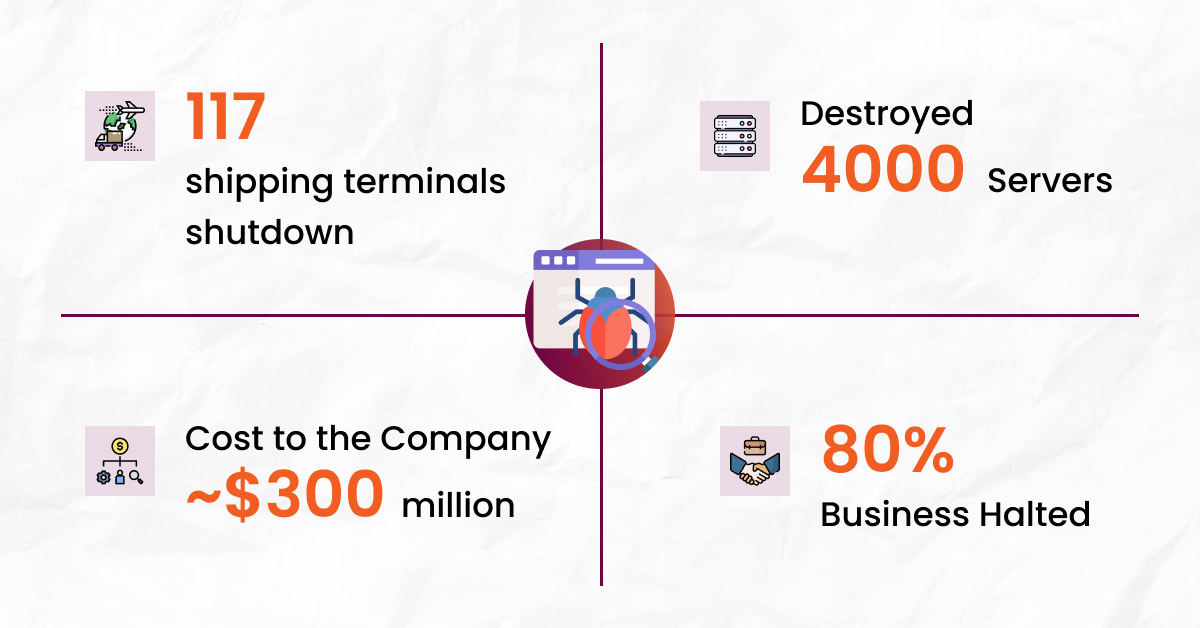
Key Takeaways:
- Backups are important: The Ghana server saved them from complete failure.
- Speed: Quick recovery limited further financial losses.
- Financial impact: Even with recovery, the disruption was costly.
Pros and Cons of Disaster Recovery
Aspect | Pros | Cons |
Cost-Effective | Cloud-based DR solutions reduce the cost of physical storage. | Initial setup for cloud or hybrid DR can be expensive. |
Data Integrity | Regular backups ensure minimal data loss. | Without frequent updates, backups can become outdated. |
Quick Recovery | Minimizes downtime by restoring systems quickly. | Systems may take longer to recover depending on infrastructure size. |
Scalability | Can easily scale to accommodate growing IT needs. | Scaling can require higher levels of expertise and cost. |
Testing | Allows for regular testing and simulation of potential disruptions. | If not tested regularly, the DR plan might not work when needed. |
Defining Business Continuity (BC)
Business continuity simply refers to the sustenance of the normal operations of an organization’s business in times of and after a disruption that may occur in each organization, such as a natural catastrophe, cyberattack, or other system failures. It is thus planning and preparing for the continuation of critical services and functions with minimal loss in time.
This often includes data backup, disaster recovery, and the use of alternative working methods. It aims to protect the business from conceivable threats to allow it to quickly recover and resume normal operations. Proper planning of business continuity can help minimize financial losses, protect brand reputation, and keep customer trust intact during unexpected events.
Key Elements of Business Continuity Plan
- Critical Business Function Identification: Identifying essential operations that must continue regardless of the disruption (e.g., customer support, payroll, etc.).
- Workforce Continuity: Ensuring employees can continue working remotely or from alternate locations.
- Supply Chain Management: Ensuring alternative suppliers or distribution channels are ready in case the primary ones fail.
- Communication Plan: Ensuring that clear, concise internal and external communication channels are open during the disruption.
- BCP Testing & Updates: Like DR, the BC plan must be regularly tested and updated to adapt to new threats and evolving business models.
Example: Hurricane Ian and Florida Businesses
Hurricane Ian landed in Florida in the beginning of September 2022, affecting the infrastructure of homes and businesses across the state with extreme damage. Companies from all sectors have been affected, with large-scale operations disrupted owing to an electrical power outage, flooding, and disruption in the supply chain. Businesses with a prepared business continuity plan, however, could continue running.
For example, Publix Super Markets, one of the country’s largest grocery chains, based in Florida had to activate its business continuity plan. This meant developing additional distribution channels, shifting stock from affected areas, and ensuring that these teams could operate out of unaffected locations. The company used work-from-home strategies and cloud-based infrastructure as ways to keep business processes running in places where the physical location was destroyed.
Key Takeaways
- Alternative supply chains: Publix avoids hurricane disruptions by routing supplies to undamaged stores.
- Remote work: businesses with cloud infrastructure were operational even after the disaster
- Proactive communication: All the businesses made clear updates, so employees and customers are informed regarding any changes in their services.
Pros and Cons of Business Continuity
Aspect | Pros | Cons |
Holistic Approach | Ensures the continuity of all business functions, not just IT systems. | Requires involvement from every department, which can delay planning. |
Minimizes Operational Impact | Keeps the business operational even during a major disaster. | It can be complex and time-consuming to implement across large organizations. |
Workforce Flexibility | Offers strategies for remote work, ensuring employees can work from anywhere. | Requires regular training and updates to keep staff informed of procedures. |
Why Disaster Recovery and Business Continuity Matter?
Disaster Recovery (DR) and Business Continuity (BC) are vital for any business. DR helps restore IT systems after disruptions, while BC keeps business operations running smoothly. Together, they minimize financial losses and maintain customer trust. For businesses relying on cloud-based services, integrating Exchange Online Backup into the DR plan ensures that critical emails, data, and communication systems are recoverable in case of cyberattacks or system failures.
These strategies also ensure regulatory compliance. By protecting both systems and operations, disaster recovery plan and business continuity plan help businesses recover quickly from crises and continue essential functions. This approach safeguards a company’s reputation and long-term success.
Potential Threats to Modern Businesses
The modern organizations face multiple data security risks that disclose confidential information and disrupt operations. A few common data security threats are:
- Ransomware: The malicious software encrypts data and demands payment for decryption.
- Phishing Attacks: False emails or any other form of messaging steals sensitive information such as login IDs and passwords.
- Human Error: Accidental deletion of data, poor system configurations, or dangerous practices result in costly downtime.
- Hardware Failures: An unpredictable failure of a server, hard drive, etc., would result in lost data.
- Insider Threats: Employees or contractors could reveal sensitive data either intentionally or accidentally.
- Data Breaches: Cyber criminals attain unauthorized access to confidential data
- DDoS Attacks: Application overload by traffic results in service outages and creates exposure to vulnerability
- Weak Passwords: Guessable or reused passwords may well open accounts for unauthorized access.
- Unpatched Software: Known vulnerabilities prevail in outdated systems that are wide open to exploitation.
- Data Theft by Ex-Employees: Leaving employees take valuable data along.
- Regulatory Non-Compliance: There will be legal penalties, and thus, loss of trust due to this failure to keep to the industry regulations.
- Third-Party Vulnerabilities: Third-party vulnerabilities refer to potential security risks coming from vendors or partners with weak protection measures.
- Cloud Security Risks: Misconfigurations or unauthorized access in the cloud environment.
When to Prioritize Disaster Recovery (DR) and Business Continuity (BC)?
The distinction between Disaster Recovery (DR) and Business Continuity (BC) is important, but often it comes down to the current state of your business.
When to Focus on Disaster Recovery (DR)?
- Serious disruption to the IT service: If you are experiencing an event where a legitimate server crash, leading violation of a data breach, or an emergency due to a natural disaster has taken place, focus on recovery. The goal is to restore the environment and services to a scheduled operational state.
- Risk of financial loss: If there is a serious risk of valuable data being lost, initiate the DR process to recover data and/or minimize downtime.
When to Prioritize Business Continuity (BC)?
- Keeping Operations Running: If the bigger concern is making sure your whole business continues to function smoothly during a disruption (like customer service or the supply chain), then BC is the priority. It’s not just about IT, but ensuring all key processes stay on track.
- Long-Term Resilience: If you’re thinking about how to keep things running in the face of ongoing risks like a pandemic or an economic downturn, BC is your focus to ensure the business stays resilient.
So, if your immediate issue is getting systems back up, focus on DR. If the goal is to maintain operations across the board, focus on BC. Both are crucial, but your current situation will tell you which to lean on more.
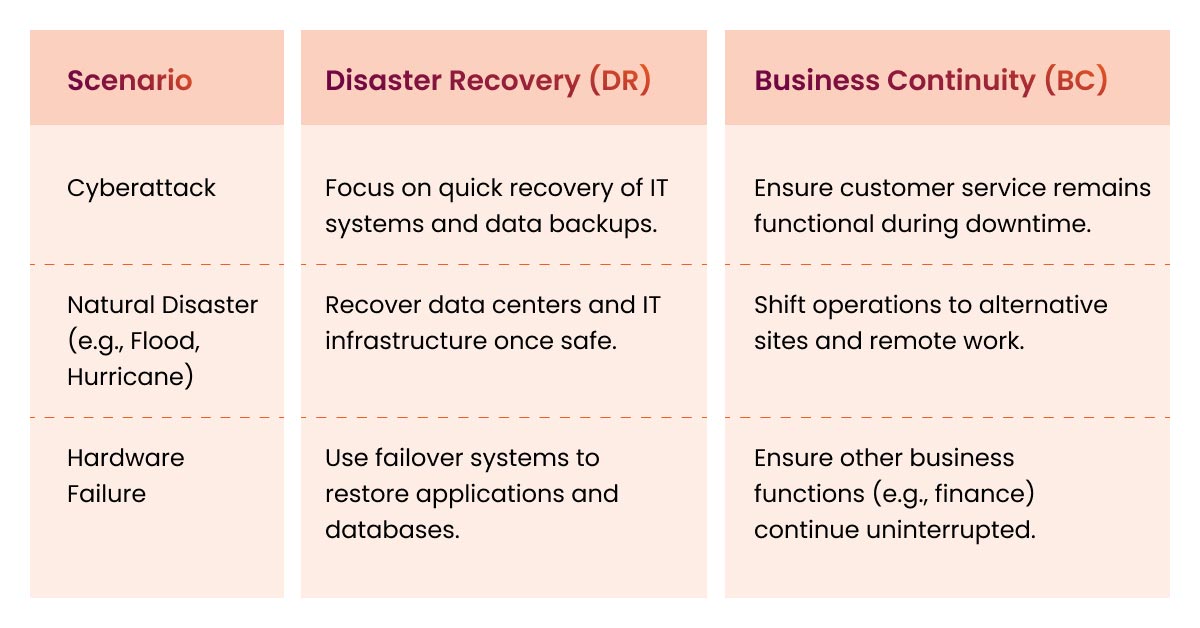
Core Components of Effective Disaster Recovery Plans
A reliable DR strategy is essential for preserving key business information and continuity of business in general. Below are some of the core elements that form a practical DR strategy:
Back Up and Restore:
Every disaster recovery plan has a central element: a sure data backup plan. Frequent schedules for backups should be undertaken to ensure that critical data and systems can be recovered at the time of disaster or system failure. Those backups ought to have automated and secure offsite or cloud storage.
Minimizing Downtime
One of the most important objectives of any DR plan is to minimize downtime. For every minute that system operations are brought to a standstill, critical monetary and practical losses may be incurred.
Testing and Updates:
No disaster recovery plan should ever be set and forget it. Testing should be performed at regular intervals to ensure that your recovery processes work as designed. This may include simulated disaster scenarios to identify weaknesses or areas for improvement.
RTO and RPO:
Both RTO and RPO are critical if your disaster recovery plan is going to support the operations of your business and risk appetite.
- RTO refers to the time within which you expect to have your systems up and running again after a disaster. The shorter the RTO, the quicker the systems’ recovery and the less amount of downtime.
- RPO refers to the amount of data loss that can be tolerated, measured in time. For instance, if the RPO is one hour, then you should be performing at least one back up every hour so as not to lose more than an hour’s worth of data.
How To Develop a Business Continuity Plan?
- Risk Assessment: Identify potential threats, from cyberattacks to natural disasters, and their likelihood.
- Critical Function Identification: Determine which business functions need to remain operational.
- Communication Strategy: Ensure all employees and stakeholders know their roles during an event.
- Alternative Work Locations: Establish secondary work sites or remote work capabilities.
- Supply Chain Management: Plan for alternative suppliers and distribution methods in case the primary ones fail.
- Test and Update Regularly: Like DR, the BC plan must be tested and updated to remain relevant.
Overlaps in Business Continuity and Disaster Recovery Planning
Many have thought that Business Continuity (BC) and Disaster Recovery (DR) are very different processes, but they have some overlaps that are quite crucial for minimizing business disruptions. Both make provisions for maintaining operations during and after a disaster to ensure that a company can keep delivering products and services even under the most adverse conditions.
Overlapping areas of importance
A comprehensive BC/DR program would involve the creation of a robust backup plan. These backups are used for restoration and post-restoration of data, applications, and systems following a disaster or general operational failure.
On-Site and off-site testing
Preparation of a BC/DR plan usually mandates that there be regular testing of the plans so that they work as intended. Testing identifies potential gaps or weaknesses in the recovery process and helps streamline the approach.
Cross-departmental collaboration
However, the proper planning of BC and DR involves interdepartmental collaboration between IT teams, business units, and leadership. Coordination in this regard would ensure that efforts toward recovery are aligned to enable a cohesive reaction to disruptions.
Why Integration Matters?
With Business Continuity and Disaster Recovery integrated, an organization will take a more holistic approach to strengthening its resilience. Decreased downtime, faster response times, and better continuity of critical functions are all resultant characteristics of shared resources, joint testing, and aligned recovery goals.
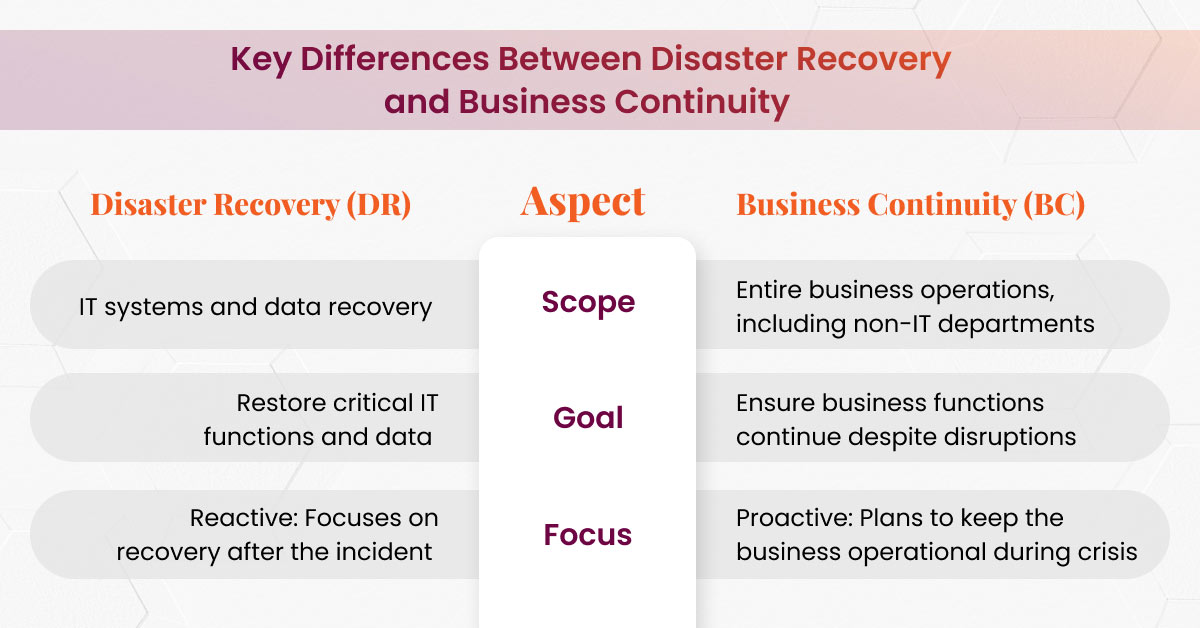
5 Steps to Disaster Recovery Plan
An excellent DRP ensures that your business returns to normal as fast as possible in the shortest time after a disaster. Here is quite simply how to do it:
- Risk Assessment:
Identify potential things that can go wrong. The kind of thing could be in the form of cyberattacks, a power outage, or a natural disaster. The next step will be establishing how such an event would affect your business.
- Establish Recovery Objectives
Determine how quickly you will need to have systems recovered, including such factors as its Recovery Time Objective or RTO and the amount of data loss that is acceptable, or its Recovery Point Objective or RPO.
- Back Up Your Data
You want to establish a good backup system. You should make sure you have cloud as well as local backups set up.
- Step-by-Step Plan
Let’s specifically document what needs to be done when disaster strikes. It should include what systems need restored, who is supposed to do what, and how you will communicate with your team and customers.
- Test and Update the Plan
Conduct tests of your plan quite often. Test a real-life scenario to check if your recovery process is quick enough.
After setting up these five steps, then you would be perfectly set to keep running the business fluently even during tough times.
Key Takeaways for “Must Do”
- Integrate Both DR and BC: You must align DR and BC to ensure full operational resilience.
- Set Realistic RTO and RPO: Define achievable recovery time and data loss objectives.
- Test Frequently: Regularly test both plans to ensure they’re effective in real-world scenarios.
- Focus on People and Processes: Business continuity is more than an IT recovery. So, try focusing on maintaining overall operations.
- Leverage Cloud Technologies: Cloud-based disaster recovery is cost-effective and scalable.
Parablu’s Secure Backup Solutions for Seamless Disaster Recovery and Business Continuity
During Disaster Recovery (DR) or Business Continuity (BC), Parablu ensures your business stays resilient by protecting your data. With secure cloud backups and smart incremental updates, your data is always protected and easy to recover, minimizing downtime.
- Fast, reliable recovery
- Data always protected
Parablu’s ransomware protection and Zero Trust security ensure that backups remain safe from attacks. Whether you’re facing a cyber threat or natural disaster, Parablu provides seamless recovery with centralized management, allowing quick restoration and continued business operations. Trust Parablu to keep your data accessible, secure, and recoverable in the event of any disaster.
Conclusion
Summarizing this, disaster recovery and business continuity should not be regarded as two opposite approaches but as complementary ones. Together, these two elements play crucial roles in reducing disruptive nature and ensuring long-term business resilience. For the CISO and the CTO, the bottom line is combining these two elements into one harmonious, tested plan addressing both technical recovery but also business operations, people, and processes. Parablu ensures seamless business continuity and disaster recovery. It offers secure, reliable data backups and ransomware protection. With a Zero Trust security model, your data stays safe and accessible. Parablu makes recovery quick and efficient, even during unexpected disruptions.
By ensuring the organization has both a disaster recovery plan and a business continuity plan, you can navigate through any crisis with minimal disruption. This will ensure the business stays afloat while maintaining customer trust and stakeholder confidence.
